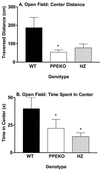Female preproenkephalin-knockout mice display altered emotional responses
- PMID: 11172058
- PMCID: PMC29364
- DOI: 10.1073/pnas.98.4.1958
Female preproenkephalin-knockout mice display altered emotional responses
Abstract
The endogenous opioid system has been implicated in sexual behavior, palatable intake, fear, and anxiety. The present study examined whether ovariectomized female transgenic preproenkephalin-knockout (PPEKO) mice and their wild-type and heterozygous controls displayed alterations in fear and anxiety paradigms, sucrose intake, and lordotic behavior. To examine stability of responding, three squads of the genotypes were tested across seasons over a 20-month period. In a fear-conditioning paradigm, PPEKO mice significantly increased freezing to both fear and fear + shock stimuli relative to controls. In the open field, PPEKO mice spent significantly less time and traversed significantly less distance in the center of an open field than wild-type controls. Further, PPEKO mice spent significantly less time and tended to be less active on the light side of a dark-light chamber than controls, indicating that deletion of the enkephalin gene resulted in exaggerated responses to fear or anxiety-provoking environments. These selective deficits were observed consistently across testing squads spanning 20 months and different seasons. In contrast, PPEKO mice failed to differ from corresponding controls in sucrose, chow, or water intake across a range (0.0001-20%) of sucrose concentrations and failed to differ in either lordotic or female approach to male behaviors when primed with estradiol and progesterone, thereby arguing strongly for the selectivity of a fear and anxiety deficit which was not caused by generalized and nonspecific debilitation. These transgenic data strongly suggest that opioids, and particularly enkephalin gene products, are acting naturally to inhibit fear and anxiety.
Figures





References
-
- Fanselow M S. Learn Motiv. 1981;12:398–419.
-
- Fanselow M S, Bolles R C. J Comp Physiol Psychol. 1979;94:736–744. - PubMed
-
- Lester L S, Fanselow M S. Physiol Psychol. 1986;14:5–10.
-
- Fanselow M S, Sigmundi R A. J Exp Psychol Anim Behav Processes. 1986;12:301–309. - PubMed
-
- Fanselow M S, Calcagnetti D J, Helmstetter F J. Brain Res. 1988;444:147–152. - PubMed
Publication types
MeSH terms
Substances
Grants and funding
LinkOut - more resources
Full Text Sources
Molecular Biology Databases

